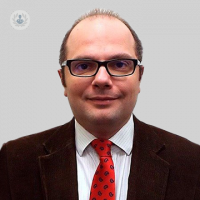Ask an expert: Why is regular cervical screening so important?
Written in association with:Cervical screening, also sometimes known as smear testing, is a routine but vitally important medical examination that can identify precancerous cells, meaning that early treatment can be provided. This is known to drastically lower a woman’s risk of developing cervical cancer, making cervical screening a key element of women’s health care. In this informative guide to cervical screening, highly respected consultant in gynaecology and gynaecological oncology surgery Mr Ahmad Sayasneh details how and when this type of testing is performed and the role it plays in preventing cervical cancer.

Why is cervical screening so important?
Cervical screening is very important because we have very robust evidence to suggest that it is an efficient way to reduce the risk of cervical cancer. It is one of the branches of prophylactic medicine that we doctors use to make sure that there is no precancerous disease. Should precancerous cells be present, this can be treated easily which is the way to prevent cervical cancer.
What exactly does cervical screening entail?
There are two elements of cervical screening. First, the type of cells hanging on the cervix is established and we identify if they are normal or abnormal. If they are identified as abnormal, we also determine what level of abnormality they are at and each level of abnormality can be related to a level of disease in the cervix. One or two of these levels can be pre-cancerous.
The other element of cervical screening is HPV testing. In the NHS, there has been a move to perform HPV testing alone as the cervical screening method. However, in the private sector we continue to perform both the HPV testing and the test for abnormalities of the cells.
The evidence so far suggests that if the HPV testing is negative, then there is no need to test the type of cells. However, from time to time we still pick up some abnormal cells which are not related to HPV, such as those coming from the lining of the womb which can hang in the cervix sometimes. In this eventuality, we can also pursue further investigation to check this abnormality.
How is cervical screening performed?
Cervical screening tests are very easy to perform. It is an intimate examination in the clinic where we ensure a completely private set-up and the chaperone is also present. We explain to the patient that the test is like a speculum examination of the vagina during which we visualise the cervix and very gently take some cells hanging on the cervix using a special brush. Some patients feel a little bit of discomfort but others feel nothing. In rare cases, some patients report some scratching on the cervix and they may experience a little bit of spotting after the procedure.
What can be diagnosed through cervical screening?
Cervical screening helps us to diagnose cervical cancer, pre-cancerous disease and HPV related problems with the cervix. Additionally, as I mentioned before, we can also diagnose some abnormalities from the lining of the womb, often in younger women but sometimes in menopausal patients.
How regularly should women undergo cervical screening?
There is a cervical screening schedule which we respect and this depends on the patient’s age. Normally, we do not perform this type of testing before the age of twenty five. In some very specific circumstances, however, we may perform one or two smear tests before this age. Between the ages of twenty five and fifty, cervical screening is usually performed every three years.
Following this, the frequency reduces to between every three and five years. After the age of sixty five, we don’t continue to perform cervical screening because the risk of developing cervical cancer falls quite low. If the patient sticks to this schedule, the chances of developing cervical cancer are extremely low.
If you are concerned about cervical cancer and would like to book a consultation with Mr Sayasneh, you can do so by visiting his Top Doctors profile.


